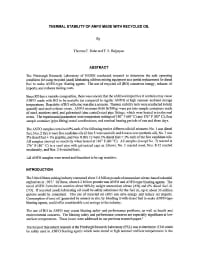Mining Publication: Thermal Stability of ANFO Made with Recycled Oil
Original creation date: February 1999
Authors: TC Ruhe, TS Bajpayee
NIOSHTIC2 Number: 20024508
Proceedings of the 25th Annual Conference on Explosives and Blasting Technique, Nashville, Tennessee, February 7-10, 1999. Cleveland, OH: International Society of Explosives Engineers, 1999 Feb; 2:263-271
The NIOSH Pittsburgh Research Laboratory conducted research to determine the safe operating conditions for using recycled (used) lubricating oil from mining equipment as a partial replacement for diesel fuel to make ANFO-type blasting agents. The use of recycled oil (RO) conserves energy, reduces oil imports, and reduces mining costs. Since RO has a variable composition, there was concern that the additives/impurities it contains may cause ANFO made with RO to be unstable (as compared to regular ANFO) at high summer ambient storage temperatures. Reactivity of RO with zinc was also a concern. Thermal stability tests were done to help quantify and resolve these issues. ANFO mixtures (0.66 lb (300 g)) were put into sample containers made of steel, stainless steel, and galvanized (zinc-coated) steel pipe fittings, which were heated in isothermal ovens. The experimental parameters were temperature settings of 140 deg F (60 deg C) and 176 deg F (80 deg C), four sample container (pipe fitting) metal combinations, and nominal heating periods of 1 and 3 days. The ANFO samples contained 6% each of the following 12 different oils/oil mixtures: No. 1 was diesel fuel, Nos. 2-6 were five candidate oils (2-5 were used oils and 6 was a new synthetic oil), No. 7 was 5% diesel fuel + 1% graphite, and Nos. 8-12 were 3% diesel fuel + 3% each of the five candidate oils). All samples showed no reactivity when heated at 140 deg F (60 deg C). All samples (except No. 7) reacted at 176 deg F (80 deg C) in a steel pipe with galvanized caps as follows: No. 1 reacted most, Nos. 8-12 reacted moderately, and Nos. 2-6 reacted least. All ANFO samples were tested and found not to be cap-sensitive.

NIOSHTIC2 Number: 20024508
Proceedings of the 25th Annual Conference on Explosives and Blasting Technique, Nashville, Tennessee, February 7-10, 1999. Cleveland, OH: International Society of Explosives Engineers, 1999 Feb; 2:263-271
- Aerosols Emitted in Underground Mine Air by Diesel Engine Fueled with Biodiesel
- The Availability of Primary Copper in Market Economy Countries: A Minerals Availability Appraisal
- Effectiveness of Iron-Based Fuel Additives for Diesel Soot Control
- The Effects of Ventilation and Preburn Time on Water Mist Extinguishing of Diesel Fuel Pool Fires
- The Effects of Water Emulsified Fuel on Diesel Particulate Matter Concentrations in Underground Mines
- Factors Affecting ANFO Fumes Production
- Low Temperature Limits for Mixing Recycled Oil, Diesel Fuel, and Ammonium Nitrate to Make ANFO-Type Blasting Agents
- Nature and Cost of Low Back Pain
- A Review of Recent Accidents Involving Explosives Transport
- Work-Principle Model for Predicting Toxic Fumes of Nonideal Explosives